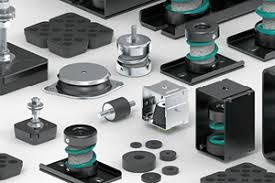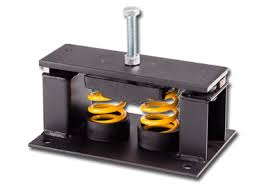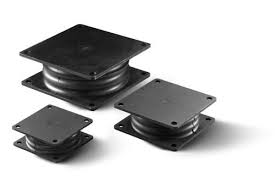spring vibration isolators Rubber vibration isolation mounts are crucial components for minimizing the transmission of vibration and noise in various industrial applications. Choosing the right mounts for your specific needs is essential to ensure optimal performance and protection of equipment. In this article, we will discuss the key factors to consider when selecting rubber vibration isolation mounts to meet your requirements and effectively isolate vibrations in your machinery and equipment.
Choosing the right rubber vibration isolation mounts for your needs requires considering various factors such as the weight and size of the equipment to be mounted, the level of vibration and shock isolation required, and the environmental conditions the mounts will be exposed to. It is important to select mounts that are capable of supporting the weight of the equipment while effectively reducing vibration and shock transmission. Additionally, considering the flexibility, durability, and temperature resistance of the mounts is essential for long-term vibration isolators hvac performance. Conducting a thorough assessment of your specific requirements and consulting with a vibration isolation specialist can help ensure you choose the most suitable rubber mounts for your application.
When choosing the right rubber vibration isolation mounts, it’s crucial to consider the application and the specific requirements. Factors to bear in mind include hvac vibration isolators the weight of the equipment, the frequency and magnitude of the vibrations, environmental conditions, and the required level of isolation. Additionally, the flexibility, durability, and temperature resistance of the mounts are important to ensure long-term performance and effectiveness. It is recommended to consult with a vibration isolation specialist and conduct a detailed assessment of your needs to select the most suitable rubber mounts for your application.
Understanding the Role of Rubber Vibration Isolation Mounts in Machinery

Rubber vibration isolation mounts are crucial components in machinery as they help in minimizing the transmission of vibrations from the equipment to the surrounding environment. These mounts are designed to absorb the vibrations generated by the machinery, which not only reduces noise levels but also prevents potential damage to the equipment and surrounding structures. By understanding the role of rubber vibration isolation mounts, manufacturers and operators can effectively mitigate the negative impact of vibrations on machinery and improve overall operational efficiency.
The Importance of Choosing the Right Rubber Vibration Isolation Mounts

Choosing the right rubber vibration isolation mounts is crucial for ensuring the proper functioning and longevity of machinery and equipment. These mounts help to reduce the transmission of vibration and noise to the surrounding environment, as well as protect the equipment from damage caused by excessive vibration. Factors to consider when selecting the right rubber vibration isolation mounts include the weight and size of the equipment, the frequency and magnitude of the vibrations, as well as the specific environmental conditions in which the equipment will be operating. Using the wrong type of mount can result in inadequate vibration isolation, leading to increased wear and tear on the equipment, decreased efficiency, and potential safety hazards. Therefore, it is important to carefully assess the requirements of the application and choose the appropriate mounts to ensure optimal performance and long-term reliability.
Advantages of Using Rubber Vibration Isolation Mounts in Industrial Settings

Rubber vibration isolation mounts offer several advantages in industrial settings. They are effective at reducing the transmission of vibration and noise, which can help to improve working conditions and safety for employees. Additionally, rubber mounts can help to prolong the lifespan of machinery and equipment by absorbing shock and vibration. This can lead to reduced maintenance and repair costs over time. Rubber mounts are also resistant to most oils and chemicals, making them suitable for use in various industrial environments. Overall, the use of rubber vibration isolation mounts can contribute to a more efficient and productive work environment.
Common Applications of Rubber Vibration Isolation Mounts

Rubber vibration isolation mounts are commonly used in a variety of applications to reduce the transmission of vibration and noise. They are often utilized in industrial machinery, HVAC systems, automotive applications, and even in appliances and electronic equipment. These mounts help to absorb and isolate the vibrations produced by machinery or equipment, which can improve performance, reduce wear and tear, and enhance the comfort and safety of the surrounding environment. Additionally, rubber vibration isolation mounts are also used in marine and aerospace applications to minimize the impact of vibrations and shocks on sensitive equipment and components. Overall, these mounts play a crucial role in reducing noise and vibration in a wide range of systems and equipment.
Factors to Consider When Installing Rubber Vibration Isolation Mounts
isolation mount
1. Load Capacity: Ensure that the rubber mounts can support the weight and load of the equipment or machinery being isolated. 2. Environmental Conditions: Consider the temperature, chemical exposure, and other environmental factors that may affect the performance and lifespan of the rubber mounts. 3. Isolation Efficiency: Evaluate the effectiveness of the rubber mounts in isolating vibrations and preventing transmission to nearby structures or equipment. 4. Installation Methods: Choose the appropriate installation method for the specific application, whether it's a simple bolt-down or a more complex leveling and alignment process. 5. Compatibility with Equipment: Verify that the rubber mounts are compatible with the specific equipment and its mounting requirements. 6. Maintenance Requirements: Consider the maintenance needs of the rubber mounts and ensure that they can be easily inspected and replaced if necessary. 7. Regulatory and Safety Standards: Ensure that the rubber mounts meet relevant safety and industry standards for vibration isolation in the intended application.
Choosing the Right Material for Rubber Vibration Isolation Mounts
Rubber vibration isolation mounts are commonly used in various industries to reduce the transmission of vibrations from machinery and equipment to the surrounding environment. When choosing the right material for these mounts, it is important to consider the specific requirements of the application. One of the most important factors to consider is the type of vibration that needs to be isolated. High frequency vibrations may require a different material than low frequency vibrations. Additionally, the weight and size of the equipment being mounted will also impact the material selection. Natural rubber is a common choice for vibration isolation mounts due to its elasticity and ability to effectively absorb and dissipate vibrations. However, synthetic rubbers such as neoprene or silicone may be more suitable for certain applications, such as those requiring resistance to oils, chemicals, or extreme temperatures. It is also important to consider the durability and longevity of the material, as well as its ability to withstand environmental factors such as UV exposure and moisture. Conducting a thorough analysis of the specific requirements and environmental conditions will help in selecting the most appropriate material for rubber vibration isolation mounts.
Frequently Asked Questions About Rubber Vibration Isolation Mounts
Rubber vibration isolation mounts are commonly used in industrial and commercial settings to reduce the transmission of vibrations from machinery and equipment. Here are some frequently asked questions about rubber vibration isolation mounts: 1. What are rubber vibration isolation mounts? Rubber vibration isolation mounts are devices made of rubber and often metal components that are used to isolate vibrations and reduce the transmission of noise from machinery and equipment. 2. How do rubber vibration isolation mounts work? Rubber vibration isolation mounts work by absorbing and dissipating vibrations from machinery and equipment, effectively isolating the source of vibration from the surrounding environment. 3. What are the benefits of using rubber vibration isolation mounts? Using rubber vibration isolation mounts can help reduce noise and vibrations, protect machinery and equipment from damage, improve work environment safety, and increase the longevity of machinery and equipment. 4. How do I choose the right rubber vibration isolation mounts for my application? When selecting rubber vibration isolation mounts, it's important to consider factors such as the weight and dimensions of the equipment, the frequency and amplitude of vibrations, and the environmental conditions in which the mounts will be used. 5. How do I install rubber vibration isolation mounts? Rubber vibration isolation mounts are typically installed by securing them to the machinery or equipment using bolts or other fastening methods. It's important to follow the manufacturer's guidelines for proper installation. 6. Do rubber vibration isolation mounts require maintenance? Rubber vibration isolation mounts may require periodic inspection and maintenance to ensure they are functioning properly. This may include checking for wear and tear, replacing worn mounts, and re-torquing fasteners. 7. Can rubber vibration isolation mounts be used in outdoor or harsh environments? Yes, there are rubber vibration isolation mounts designed specifically for outdoor or harsh environments, such as those exposed to extreme temperatures, chemicals, or moisture. It's important to select mounts that are suitable for the specific environmental conditions. 8. Are there different types of rubber vibration isolation mounts? Yes, there are various types of rubber vibration isolation mounts available, including cylindrical mounts, conical mounts, square mounts, and more. Each type is designed for different applications and has unique vibration isolation characteristics.
The Future of Rubber Vibration Isolation Mounts in Engineering and Technology
.
Rubber vibration isolation mounts are expected to play a crucial role in engineering and technology in the future. These mounts are used to isolate vibrations and reduce noise in various applications, such as industrial machinery, automotive vehicles, and electronic equipment. In engineering, the demand for more advanced and efficient vibration isolation mounts is increasing as industries strive to improve the performance and durability of their machinery. Rubber mounts offer effective vibration control, which helps to prevent damage to sensitive equipment and improve overall operational efficiency. The use of rubber vibration isolation mounts in technology is also on the rise, particularly in the automotive and electronics sectors. These mounts help to minimize the transmission of vibrations from engines and other mechanical components, which is essential for achieving better vehicle performance and passenger comfort. In electronics, vibration isolation mounts help to protect delicate electronic components from the harmful effects of vibrations, thereby improving the reliability and longevity of electronic devices. In the future, advancements in materials and design are expected to further enhance the performance of rubber vibration isolation mounts. This will lead to the development of more effective and versatile mounts that can cater to the increasingly diverse and stringent requirements of modern engineering and technology applications. Overall, the future of rubber vibration isolation mounts in engineering and technology looks promising, with continued innovation and technological advancements driving their widespread adoption across various industries.
In conclusion, selecting the right rubber vibration isolation mounts is crucial for ensuring the effective isolation of vibrations in various applications. By taking into consideration factors such as load capacity, environment, and motion control requirements, you can choose the most suitable rubber vibration isolation mounts for your specific needs. These mounts play a vital role in minimizing the impact of vibrations and improving the overall performance and longevity of equipment and machinery. Therefore, it is important to carefully evaluate and select the right rubber vibration isolation mounts to achieve optimal results.
vibration isolation types
See also
https://www.sunnexmounts.com/vibration-isolators/ https://www.hutchinsonai.com/vibration-isolation-products https://www.vibrationmounts.com/vib/catalog/vibration-isolation-products.aspx